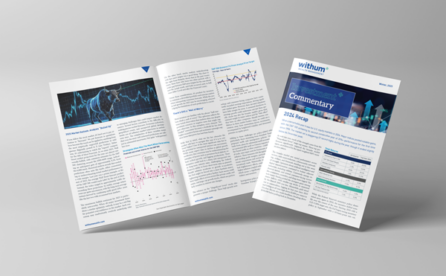The Quarter in Review:
Markets were strong during the third quarter, reversing most of the losses suffered the previous quarter. Renewed easing efforts by Central Banks around the world drove markets higher, where they are now flirting with multi-year highs. The S&P 500 Index gained 6.4% for the quarter, while the MSCI World ex US gained 7.5%. Despite the strong gains, market sentiment towards stocks remains negative, as evidenced by low volume and money moving from equities into bonds.
US Economy:
Slow Growth Continues
With second quarter GDP revised down to 1.3%, the economy remains close to what some economists are now calling “stall speed” of GDP growth near 1.5%. Any exogenous shock at these levels could potentially tilt the weak economy back into recession. As a result of this, the Federal Reserve continues its accommodative stance; its latest announcement included the launch of an open-ended $40 billion purchase of mortgage-backed securities explicitly tied to the job recovery, the extension of “Operation Twist” and the extension of the period of low interest rates until 2015.
The housing market remains encouraging; housing starts rose 2.3% and existing home sales 7.8%. Overall indicators related to the health of the real estate market such as prices, volumes and inventories of available homes continue to improve. The Fed continues to support the housing market by focusing the third round of quantitative easing on mortgage securities, aimed at lowering mortgage rates, while injecting additional liquidity into the system.
The job market recovery is still sluggish, with most improvements in the jobless rate coming from reductions in the labor force, not increases in the jobs created. However, the unemployment rate fell below the 8% level for the first time since January 2009. Several other economic indicators, such as high confidence levels, strong retail sales and improvements in ISM numbers, support an improved job market outlook going forward.
Corporate Highlights
Corporations such as Caterpillar, Intel, Norfolk Southern and Fedex have expressed cautious outlooks for next year in anticipation of further economic weakness. As the third quarter earnings season gets under way, the main focus will be forward guidance, earnings revisions and profit margin levels. We expect the results to be mixed, with single digit earnings growth for the quarter.
International:
Whatever it Takes…
The debt crisis in Europe remains unresolved and its economic growth is still subdued. However, several positive developments took place that could indicate a more permanent solution is being formulated. Mario Draghi, the head of the European Central Bank, gave markets a jolt when he said in late July that he would do “whatever it takes” to save the Euro. After that speech, Spanish and Italian bond yields fell, credit default swaps tightened and the euro gained ground against the dollar. Later during the quarter, another boost of confidence came as details of the European Central Bank bond buying program were announced. Also positive was the ratification of the European Stability Mechanism (ESM) by the German constitutional court. While these are steps in the right direction, a move towards a more fiscally integrated Eurozone is still required and the right balance between pro-growth reforms and austerity measures needs to be achieved.
In general, international monetary policy has been extremely accommodative during the quarter. The central Bank of Japan and the Bank of England expanded their quantitative easing efforts while Australia, Denmark & China lowered their rates. The Chinese government also indicated it would ramp up spending to offset a decline in growth. It is yet to be seen whether they will be able to engineer a soft landing for its economy.
The US Political Landscape:
The Countdown Begins
The focus on the election is intensifying. With only a few days left, the uncertainty continues and the race for the White House remains close. According to prediction website Intrade, the probability of President Obama being reelected hovers around 65%. Governor Romney seems to have increased his odds after a strong performance at the first presidential debate when Intrade indicated a 75% chance of reelection by President Obama. Needless to say, the outcome of the election will have a significant impact on the future direction of fiscal and tax policy of the country.
Uncertainty surrounding a way to address the U.S. Fiscal Cliff remains high. We believe Congress will likely reach a temporary agreement to postpone a more permanent solution effectively into 2013. While we view this as a positive to avoid the full force of the fiscal cliff, a clear, actionable solution to address the short and longer-term fiscal and budgetary problems of the United States is still needed.
Also Read:
→ Should You Harvest Capital Gains in 2012?
→ Dividend Tax Increases: What Should You do with Your Dividend Payers?
A Look Ahead:
A Bumpy Ride
As mentioned in our previous letter, policymakers around the world seem to be committed to encouraging growth and remain extremely accommodative. As a result, the global economy is expected to slowly improve next year. However, near term potential risks remain.
In the Unites States, uncertainty surrounding the upcoming elections is at its peak with only a few days to go before November 6th. Internationally, the sovereign crisis in Europe, the possibility of a hard landing in China and increasing geo-political tensions in the Middle East remain concerning and negative developments in any of these areas could have detrimental effects for the global recovery.
While valuations have increased as a result of the positive performance for the year, they remain attractive. Corporations with healthy balance sheets and strong free cash flow generation are still trading at a discount to their historical averages and present good entry points for long-term investors. Many investors continue to focus on the downside risks which could set the stage for positive surprises as those risks begin to subside.\
Also Read: Hurricane Sandy’s Impact on the US Economy
This quarterly letter was brought to you by the financial advisors at PWM Advisory Group – Private Wealth Management
This article was designed for educational purposes only and is not intended for specific legal, accounting, investment, income tax or other professional advice. Please remember that past performance may not be indicative of future results. Different types of investments involve varying degrees of risk, and there can be no assurance that the future performance of any specific investment, investment strategy, or product (including the investments and/or investment strategies recommended or undertaken by PWM Advisory Group, LLC [“PWM”]), or any non-investment related content, made reference to directly or indirectly in the presented material(s) will be profitable, equal any corresponding indicated historical performance level(s), be suitable for your portfolio or individual situation, or prove successful. Due to various factors, including changing market conditions and/or applicable laws, the content may no longer be reflective of current opinions or positions. Moreover, you should not assume that any discussion or information contained in this presentation serves as the receipt of, or as a substitute for, personalized investment advice from PWM. To the extent that a reader has any questions regarding the applicability of any specific issue discussed above to his/her individual situation, he/she is encouraged to consult with the professional advisor of his/her choosing. PWM is neither a law firm nor a certified public accounting firm and no portion of the presented material(s) should be construed as legal, accounting or consulting advice. A copy of the PWM’s current written disclosure statement discussing our advisory services and fees is available for review upon request. To ensure compliance with U.S. Treasury rules, unless expressly stated otherwise, any U.S. tax advice contained in this communication (including attachments) is not intended or written to be used, and cannot be used, by the recipient for the purpose of avoiding penalties that may be imposed under the Internal Revenue Code. Photo Credit: NeilsPhotography
If You Liked This Article, SHARE IT!
Help Us Spread The Word. Share This Article With Your Friends & Peers



